Do you love sweet potatoes? Have you ever thought of planting your own?
I love them and I think I’ve converted my husband too. Not so much converted him than just shown him how great they are.
There’s several different kinds of sweet potatoes. The ones most of us know, those beautiful orange sweet potatoes. But there’s also white and purple sweet potatoes. I had heard about these, but truthfully, I’ve never seen them.
I can’t speak to the white or purple ones, I’ve never had them, but I can tell you the orange ones are so good!!! If you’ve ever had the white or purple sweet potato let us know. I’m curious about those.
Sweet potatoes are highly nutritious, they taste great and can be used in so many ways. You can use them for breakfast, lunch and supper.
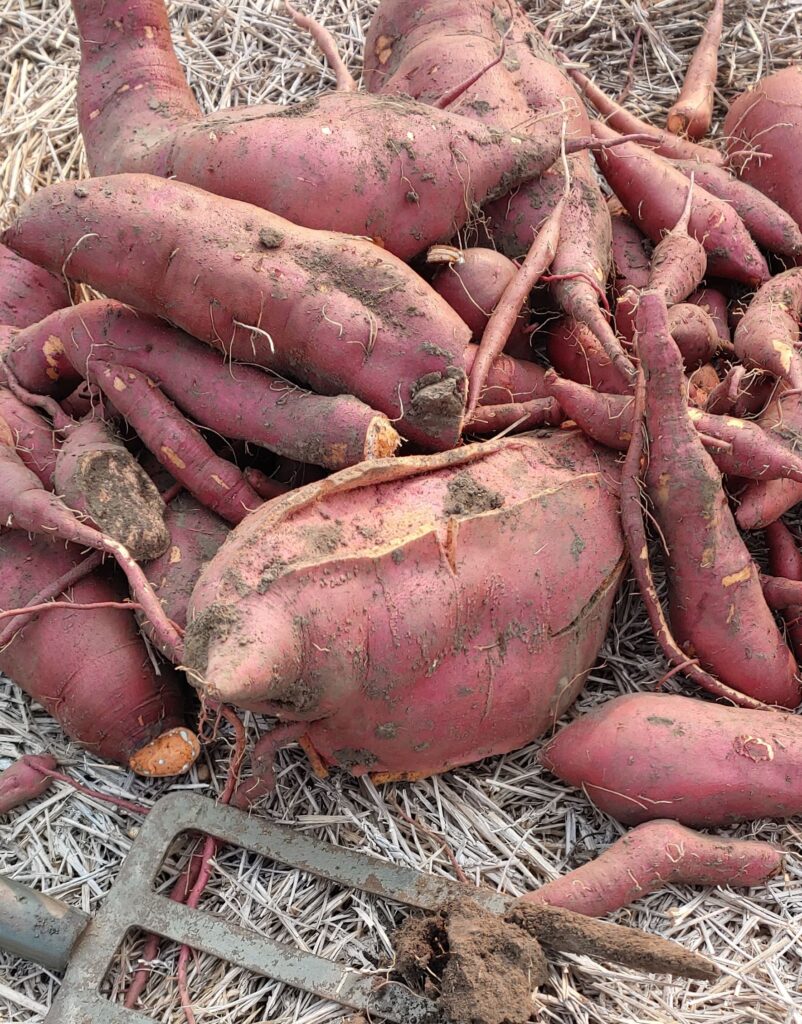
The nutrition of sweet potatoes.
Sweet potatoes are highly nutritious. Just like carrots, they’re high in beta-carotene. That’s what makes that pretty orange color. And they’re high in vitamin A too. Both of these are great for eye health.
A cup of sweet potatoes also has about 50% of your daily value of manganese. A trace mineral necessary in the metabolism of amino acids (the body’s building blocks), cholesterol, glucose & carbs.
They also have more than a quarter of the daily value of both vitamin B6 and Potassium.
Planting and growing sweet potatoes is easy.
Start by making your slips.
Sweet potatoes grow from slips rather than a cut and eye of a potato like regular potatoes do.
Did you ever seen a mason jar in a kitchen window with a sweet potato in it? The green growing off the potato is the start of a slip.
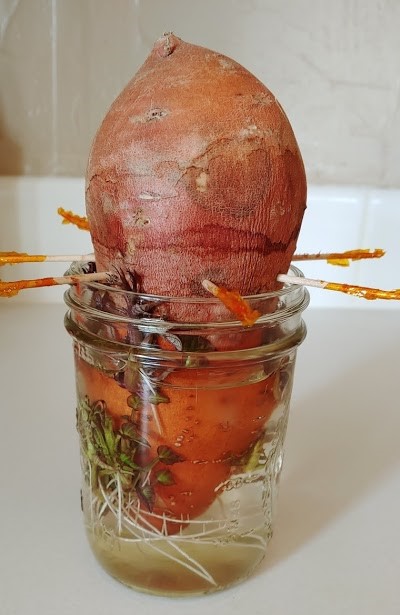
First make sure you start with an organic sweet potato. I’ve heard there is something that’s either put into some regular sweet potatoes (GMO) or on them that can keep them from growing. I’ve never checked into that really hard, but I can tell you some non-organic ones I bought from the store years back, wouldn’t grow.
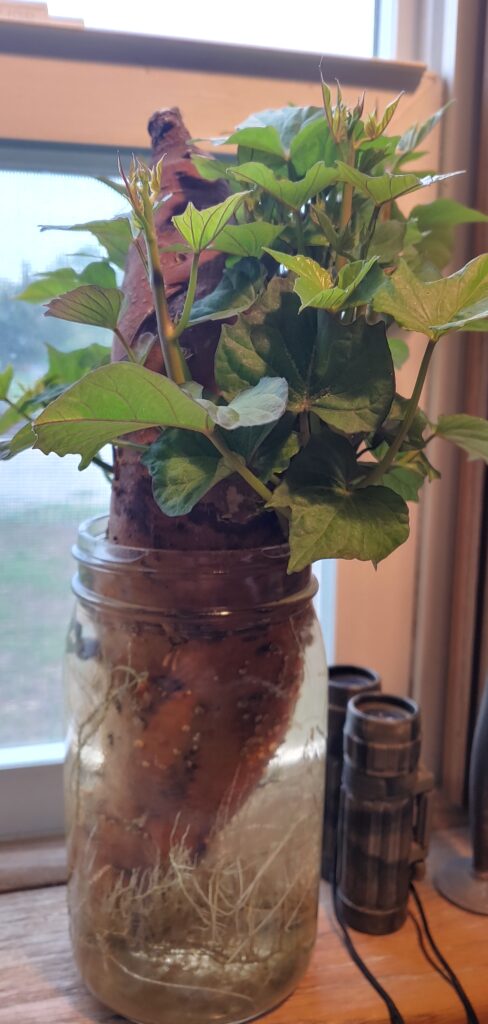
Fill your jar with water and put your sweet potato in the water. Set your jar in a sunny window, like your kitchen window over the sink. Preferably somewhere you’ll see it daily.
Then make sure you keep the jar filled with water. That’s it, you’re done.
When the sweet potato starts growing you’ll see leaves growing off the side of the potato, then the stems will begin to grow. Once a stem gets to about 6-7 inches long, pull it from the potato.
Pull the lower leaves off the stem so you don’t have leaves in the water your about to put your slip in.
I use a pint jar for these. Fill it with water and put your new slips in the jar. In a day or so you’ll begin to see roots growing.
Let a good amount of roots grow and there you have your own sweet potato slips, ready to plant.
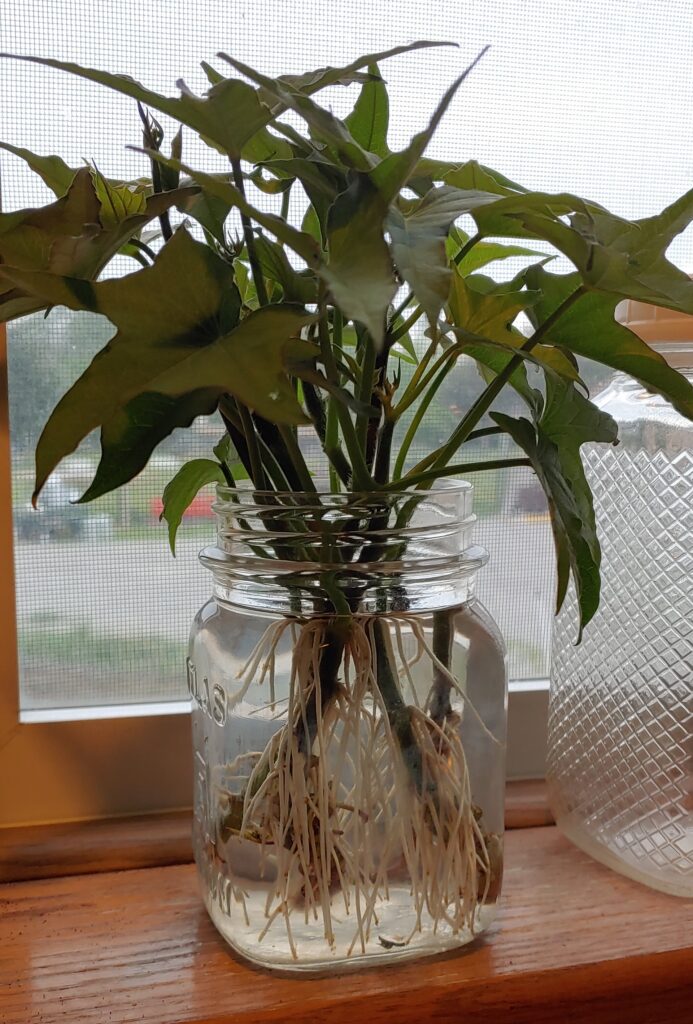
Planting your slips.
You’ll want to plant your slips after the fear of frost has passed in your area and harvest them before the first frost in your area.
They will take about 100-150 days to grow and harvest. So you can do the math for whatever works best in your area.
You’re supposed to plant them about 4 feet apart.
We planted 3 plants. In the end those 3 plants covered about a 20 x 6-7 foot area. They were HUGE and they were beautiful. There were purple morning glory-type flowers that bloomed just below the leaves.
Harvesting your sweet potatoes.
When the ends of your vines begin to yellow, they’re ready.
And let me tell you, those babies can grow!! Out of our 3 slips we harvested a couple hundred pounds of sweet potatoes. WAY MORE than I had room for, but I found it anyway.
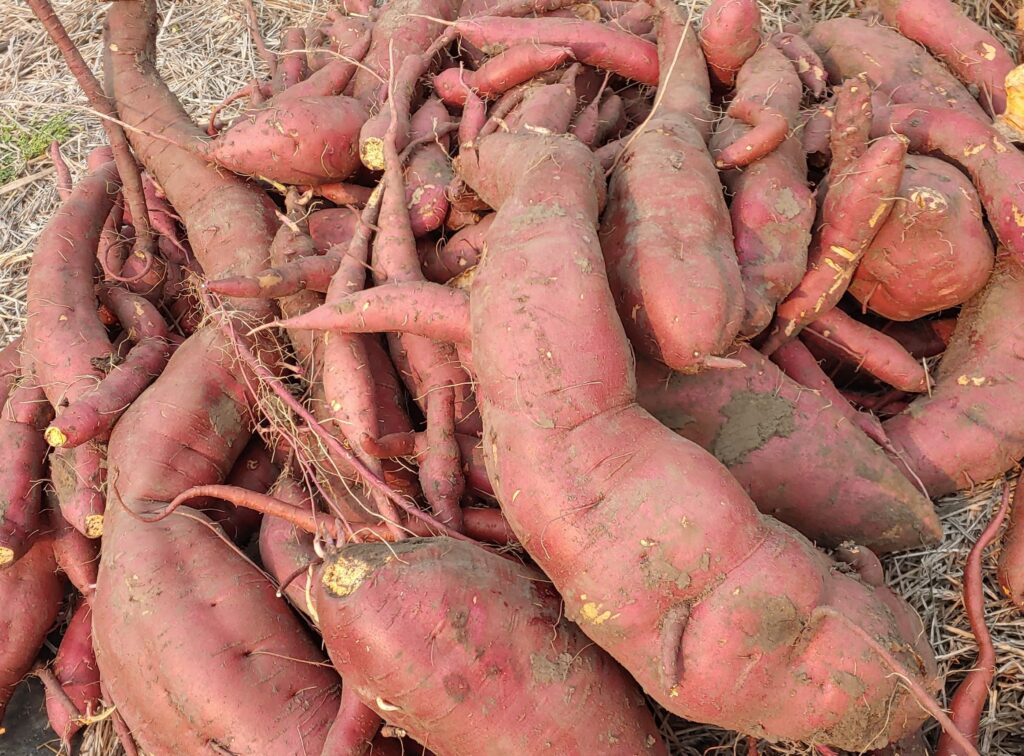
Dig them carefully, they bruise easily and the skins are thin.
Don’t wash your potatoes either, just wipe the dirt off of them.
Curing your sweet potatoes so they’re sweet.
This isn’t a hard process, but it is time consuming. Especially when your standing there looking at all those sweet potatoes you can’t eat yet.
Put them in a warm place. Everything I’ve read said in a room, back porch or something similar. In my house I don’t have a built in back porch or space in a spare bed room, mine sat on heavy wire selves in the living room, in front of a window, sitting on and covered with dark brown rugs to protect them from the wire and to keep the sun from being directly on them.
Keep them warm for 10-14 days. Then transfer them to storage in a cool, dry, dark place.
Now if you want to get technical, there are specific temps and humidity levels to use for curing potatoes. I don’t have the means of controlling those things, so this is my version of what worked for us. The Farmer’s Almanac will have those details if you want them.
Preserving your cured sweet potatoes.
There’s several ways to preserve your sweet potatoes. I’ve tried some and only read about others.
You can leave them whole and store them in a container, keeping them cool, dry and in a dark place. Some things I’ve read have said to wrap them in newspaper and put them into a paper box. You’ll want to have air flow around them so no moisture gets trapped.
Keeping them in a dark place will help prevent stems from growing off of them.
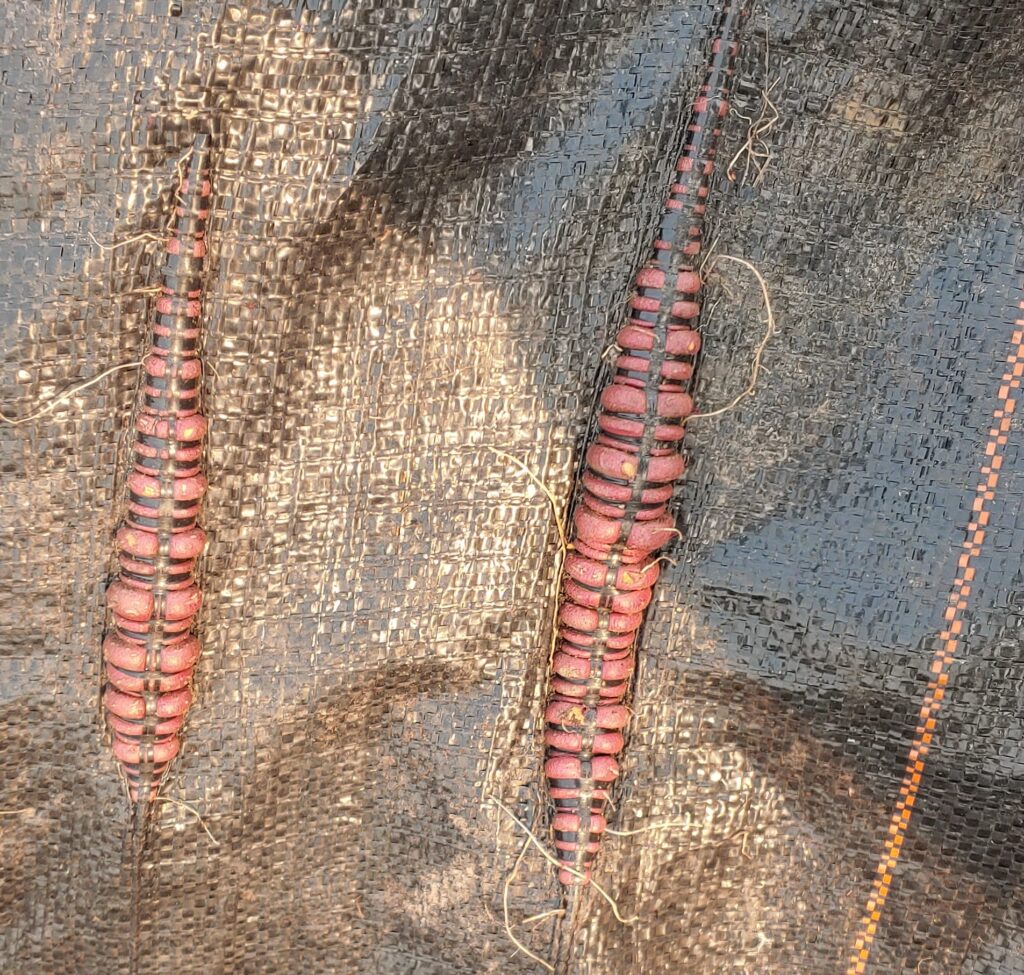
This year because I had so many, I froze a bunch. I washed them just before I was ready to use them. Cut them in about 1/2 to 3/4 inch rounds put them on a lightly oiled cookie sheet and flipped them so they were coated in oil and then roasted them for about 20 min in a 350 deg oven.
Then pulled them out, stripped the skins off (the skins come off easy after you roast them), cubed them and put them on another cookie sheet in a single layer and put them in the freezer.
Once frozen, I put them in gallon freezer bags and labelled them.
Doing it this way I can pull out just what I want and finish cooking them however I want them.
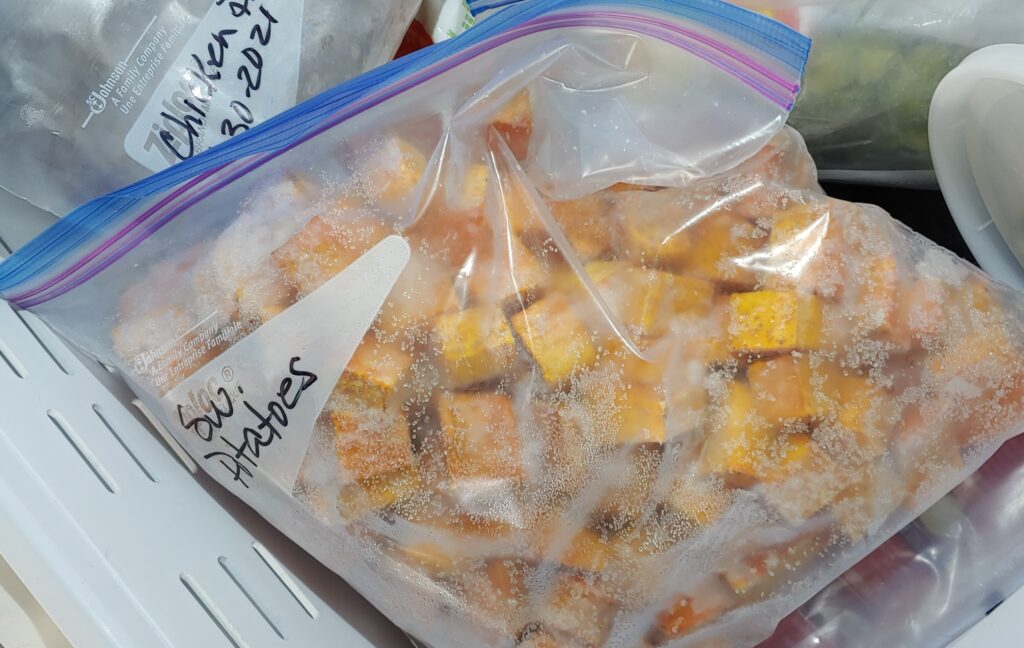
You can dehydrate them in cubes, slices or like a hash, condition* them and store. Then you can rehydrate them for cooking. Dehydrate them in whichever shape works best for you when you’re going to cook them. Maybe some of each so you can use them in different ways.
*Basically, that means to put it in a jar out of direct sunlight for 4-5 days and make sure no moisture shows. If it does you need to dehydrate them a bit more.
Eating those fabulous sweet potatoes.
Did you know the roots are not the only edible part of the plant? I didn’t know that either, until last year.
My daughter-in-law is from VietNam and apparently this is a well known fact over there. Shoot, it may be a well known fact here too, but I’ve never heard it. Sweet potatoes were not something we ever grew when I was a kid.
But she told me the leaves were great. She cooked them in butter, just like some other greens we have here like collard greens, spinach, kale, etc. I found, with a little reading that if they’re a little tough, just boil them a little bit and then sauté them in butter, oil, and what ever herbs and spices sounds good to you.
The actual roots, can be fried or baked like french fries, mashed like mashed potatoes or shredded like hash or just cubed and roasted with oil and salt and pepper. Any of these ways are so, so good.
I hope this helps you give sweet potatoes a try if you haven’t already. You only need to start with one.
Comment and let us know if your going to give it a shot!!

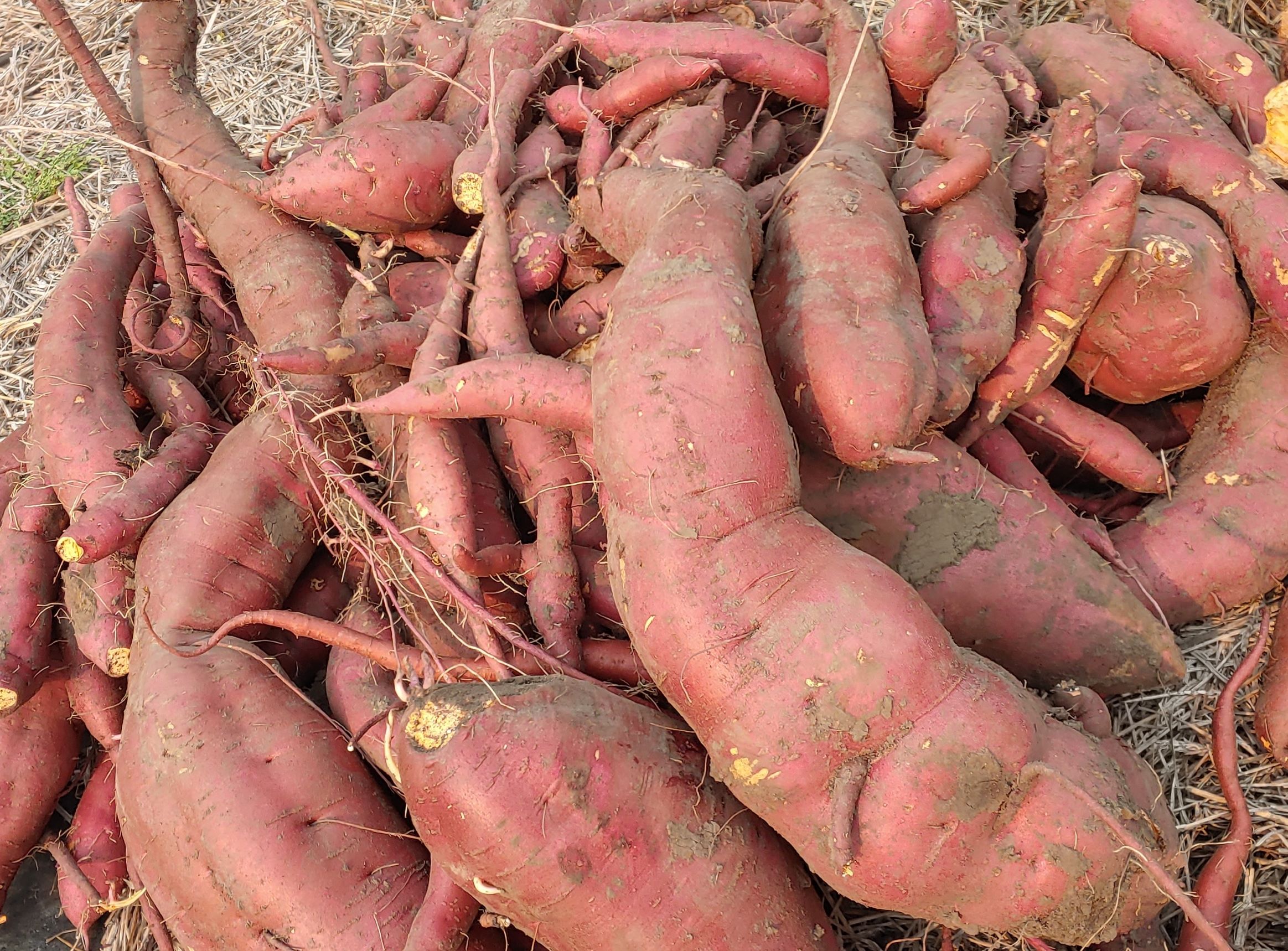
Wow, I learned so much from you post on sweet potatoes! I didn’t know how
to do the “slips”, so I just cut them up and dropped them in the ground. We had tons of sweet potatoes from a few plants. Wish I had known about curing them and roasting, then freezing them. We just bought a couple of acres to build on
and this makes me so exited about planting a garden again.
Thank you, thank you, Tracy.
Thanks so much for your Comment. I love that your so excited for next year.